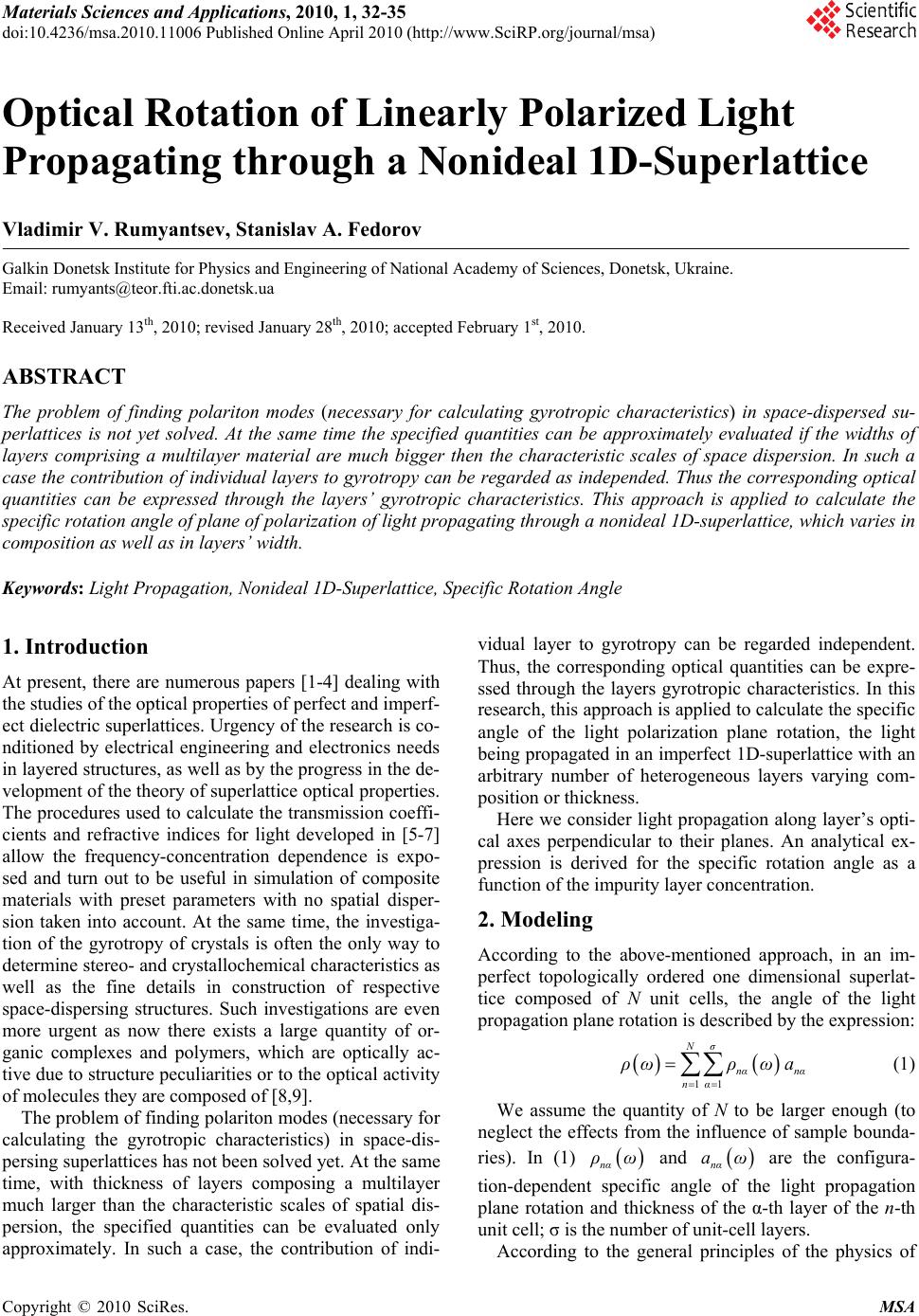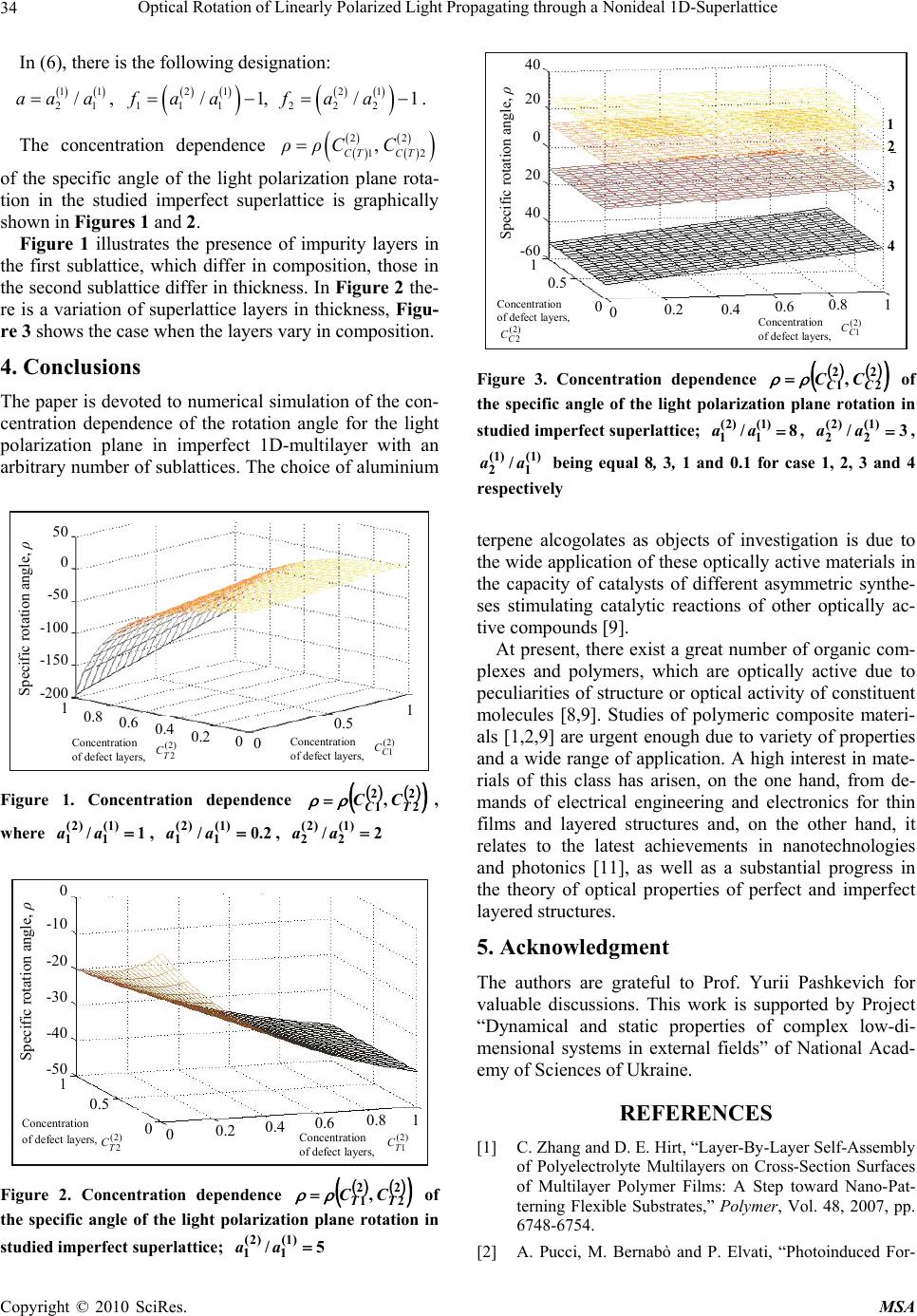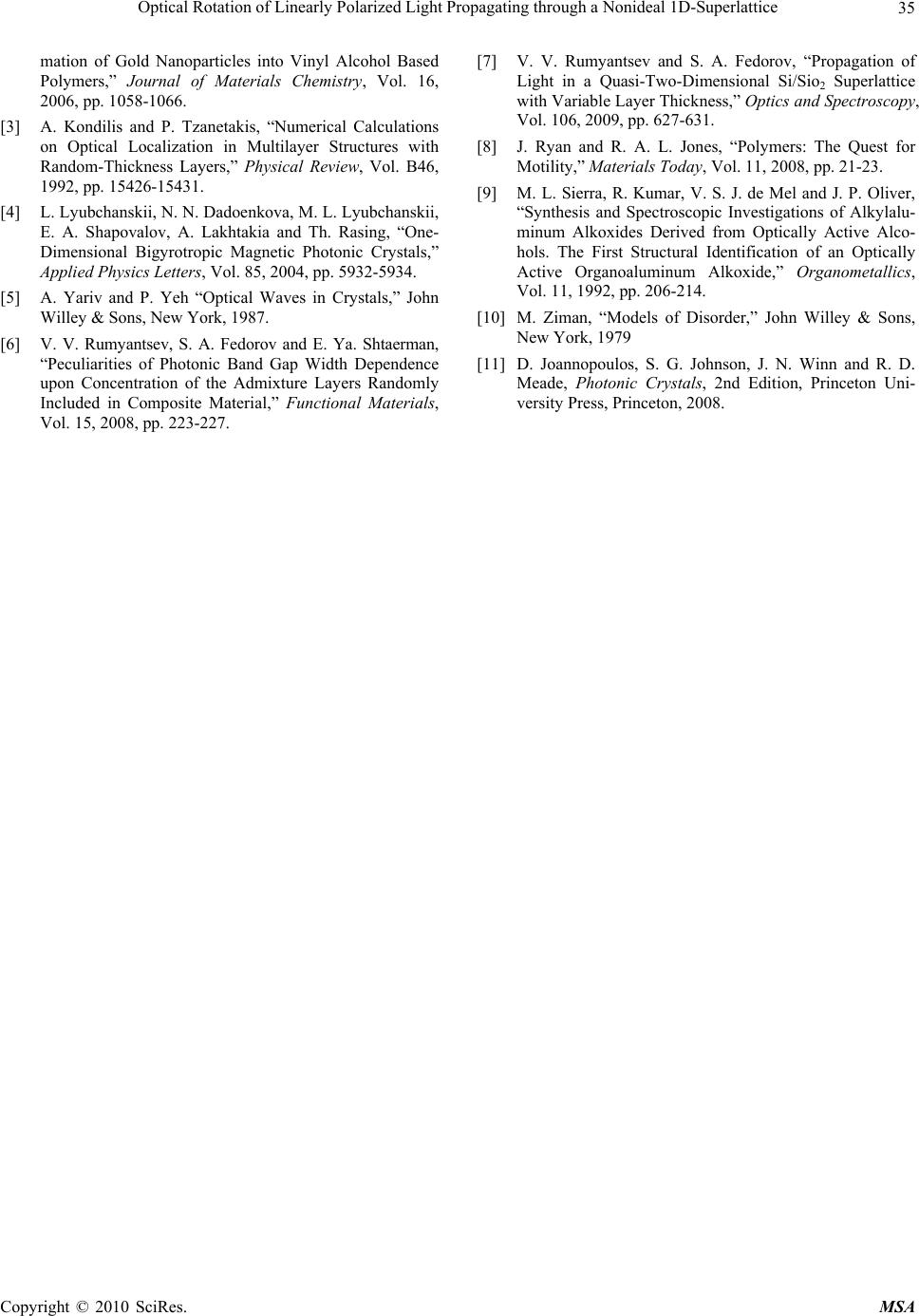Paper Menu >>
Journal Menu >>
 Materials Sciences and Applications, 2010, 1, 32-35 doi:10.4236/msa.2010.11006 Published Online April 2010 (http://www.SciRP.org/journal/msa) Copyright © 2010 SciRes. MSA Optical Rotation of Linearly Polarized Light Propagating through a Nonideal 1D-Superlattice Vladimir V. Rumyantsev, Stanislav A. Fedorov Galkin Donetsk Institute for Physics and Engineering of National Academy of Sciences, Donetsk, Ukraine. Email: rumyants@teor.fti.ac.donetsk.ua Received January 13th, 2010; revised January 28th, 2010; accepted February 1st, 2010. ABSTRACT The problem of finding polariton modes (necessary for calculating gyrotropic characteristics) in space-dispersed su- perlattices is not yet solved. At the same time the specified quantities can be approximately evaluated if the widths of layers comprising a multilayer material are much bigger then the characteristic scales of space dispersion. In such a case the contribution of individual layers to gyrotropy can be regarded as independed. Thus the corresponding optical quantities can be expressed through the layers’ gyrotropic characteristics. This approach is applied to calculate the specific rotation angle of plane of polarization of light propagating through a nonideal 1D-superlattice, which varies in composition as well as in layers’ width. Keywords: Light Propagation, Nonideal 1D-Superlattice, Specific Rotation Angle 1. Introduction At present, there are numerous papers [1-4] dealing with the studies of the optical properties of perfect and imperf- ect dielectric superlattices. Urgency of the research is co- nditioned by electrical engineering and electronics needs in layered structures, as well as by the progress in the de- velopment of the theory of superlattice optical properties. The procedures used to calculate the transmission coeffi- cients and refractive indices for light developed in [5-7] allow the frequency-concentration dependence is expo- sed and turn out to be useful in simulation of composite materials with preset parameters with no spatial disper- sion taken into account. At the same time, the investiga- tion of the gyrotropy of crystals is often the only way to determine stereo- and crystallochemical characteristics as well as the fine details in construction of respective space-dispersing structures. Such investigations are even more urgent as now there exists a large quantity of or- ganic complexes and polymers, which are optically ac- tive due to structure peculiarities or to the optical activity of molecules they are composed of [8,9]. The problem of finding polariton modes (necessary for calculating the gyrotropic characteristics) in space-dis- persing superlattices has not been solved yet. At the same time, with thickness of layers composing a multilayer much larger than the characteristic scales of spatial dis- persion, the specified quantities can be evaluated only approximately. In such a case, the contribution of indi- vidual layer to gyrotropy can be regarded independent. Thus, the corresponding optical quantities can be expre- ssed through the layers gyrotropic characteristics. In this research, this approach is applied to calculate the specific angle of the light polarization plane rotation, the light being propagated in an imperfect 1D-superlattice with an arbitrary number of heterogeneous layers varying com- position or thickness. Here we consider light propagation along layer’s opti- cal axes perpendicular to their planes. An analytical ex- pression is derived for the specific rotation angle as a function of the impurity layer concentration. 2. Modeling According to the above-mentioned approach, in an im- perfect topologically ordered one dimensional superlat- tice composed of N unit cells, the angle of the light propagation plane rotation is described by the expression: 11 Nσ nαnα nα ρωρ ωa (1) We assume the quantity of N to be larger enough (to neglect the effects from the influence of sample bounda- ries). In (1) nα ρω and are the configura- tion-dependent specific angle of the light propagation plane rotation and thickness of the α-th layer of the n-th unit cell; σ is the number of unit-cell layers. nα aω According to the general principles of the physics of  Optical Rotation of Linearly Polarized Light Propagating through a Nonideal 1D-Superlattice 33 disordered systems, the rotation angle measured experi- mentally should be equal to ˆ Pρω ρω, where is the configuration averaging operator [6,7,10] in- fluencing the configuration-dependent function ˆ P ρω. In the imperfect 1D-superlattice under consideration, the disordering is of two types, consequently, there are two types of configuration dependence. The first disorder is due to heterogeneous (defective) layers present in the superlattice, which differ from the perfect-system layers in physico-chemical composition (the configuration-dep- endent quantity is ). The second is due to layers- defects present in the system and differing in thickness from the perfect superlattice (the configuration-depend- ent quantity is ). In what follows, we believe the dis- ordering factors to be mutually independent. Quantities and relate to configuration-dependent sto- chastic variables nα ρω αn a nα a ω nα ρ μα sα η and να sα η as 1 rα μα μα nααnα μα ρω ρη (2) and sα να να nααnα να aaη (3) where 11 1, 1, rαsα μα να nαnα μα να ηη 1 μα nα η, if the-th layer of the n-th unit cell is the layer of α μα -type ( 1.2... )μα rαμ sα η and 0 - in any other case; 1 να nα η, if thickness of the -th layer of the n-th unit cell equals α να α a (να and 1.2.. )sα0ην sα - in any other case. μα α ρω α μα is the specific rotation angle of the -th layer of type. Now and then index μ enumerates layers of variable composition, - of variable thickness. ν By using (1)-(3) as well as the averaging rules [10] for ρω , we have 111 11 1 1 1 [ ]. rα σ μα μα αααα α αμα sα να να ααα να rαsα μαναμανα αααα μα νε ρω Nρωaa ρωC ρω aC ρωaC C (4) 11 , μα μανανα ααααα ρρρaaa α as well as , μα να αα CC are concentrations of defect layers which differ from lay- ers of base substance in composition and/or thickness, respectively. In expression (4), the fist summand corresp- onds to the rotation angle for the light polarization plane of perfect 1D-superlattice composed of layers of the (1)- type (this substance is assumed to be basic). The second summand stands for superlattice compositional disorder, it goes to zero in the absence of composition variation. The third summand corresponds to disordering in thick- ness (with no disordering, the summand goes to zero). And the last summand stands for superlattice disordering in layer composition and thickness at a time. In the ab- sence of any disordering, the fourth summand (4) goes to zero. In expression (4) each summand has meaning of rotation angle per unit cell. The angles, in contrast to ,μα να nα ρ (measured in deg/unit length) are measured in degrees. 3. Results For a more concrete results, let us consider the propaga- tion of electromagnetic radiation in an imperfect alumin- ium organic 1D-superlattice with two elements-layers in a cell: the first is the aluminium menthylate Al(O-Ment)3 layer ( 1 161, 2ρ ), the second—aluminium bornylate Al(O-Born)3 layer ( 1 236,7ρ ). Let the first sublattice contain impurity layer l-MentOH (), the second—l-BornOH ( 2 145,5ρ 2 235, 4ρ ) ones. Here we use values of specific rotation angles from [9]. In first and second sublattices, the concentration and the thickness of base-substance layer are denoted by 1 11 ,Ca 1 and 1 2 ,C1 2 a, respectively, 2 a (2) 1 1, CT C and 2 2 2, CT C2 a are those of the impurity (index С(Т) stands for variation of impurity layers in composition or thickness). With for- mula (4) and by simple transformations we obtain the following concentration dependence of the specific angle of rotation 22 12 ,/ СТ СТ ρρССρNd (5) (here 11 212 21 1211 122TT daaa aCaaC 2 2 is the averaged period of the cell in 1D-sublattice) for the light polarization plane in two-sublattice imperfect 1D- sublattice in the form: 1 221 112 212 121 2 111222 21 22 11 111 21 22 22 222 1[ 1 1] TT TT TC TC ρafC faCρa1 ρ ρfC ρfaC ρρ fC C ρρ faC C (6) Copyright © 2010 SciRes. MSA  Optical Rotation of Linearly Polarized Light Propagating through a Nonideal 1D-Superlattice 34 In (6), there is the following designation: 11 21 /aa a, . 21 21 1112 22 /1, /faa faa1 The concentration dependence of the specific angle of the light polarization plane rota- tion in the studied imperfect superlattice is graphically shown in Figures 1 and 2. 22 12 , СТ СТ ρρСС Figure 1 illustrates the presence of impurity layers in the first sublattice, which differ in composition, those in the second sublattice differ in thickness. In Figure 2 the- re is a variation of superlattice layers in thickness, Figu- re 3 shows the case when the layers vary in composition. 4. Conclusions The paper is devoted to numerical simulation of the con- centration dependence of the rotation angle for the light polarization plane in imperfect 1D-multilayer with an arbitrary number of sublattices. The choice of aluminium Specific rotation angle, ρ 1 0.5 0 0 0.8 1 Concentration of defect layers, )2( 1C C 0.6 50 0 -50 -100 -150 -200 Concentration of defect layers, )2( 2T C 0.2 0.4 Figure 1. Concentration dependence 2 2 2 1,ТС СС 2/ )1( 2 )2( 2a , where , , 1/ )1( 1 )2( 1aa 2.0/ )1( 1 )2( 1aa a Concentration of defect layers, )2( 2 T C Specific rotation angle, ρ 1 0.5 0 0.2 Concentration of defect layers, )2( 1T C 0.6 0 -10 -20 -30 -40 -50 1 00.4 0.8 Figure 2. Concentration dependence 2 2 2 1,TT СС 5 )1 of the specific angle of the light polarization plane rotation in studied imperfect superlattice; /( 1 )2( 1aa Concentration of defect layers, )2( 2C C 40 20 0 20 40 -60 Specific rotation angle, ρ 1 0.5 000.2 0.4 0.8 1 Concentration of defect layers, )2( 1C C 0.6 1 2 3 4 Figure 3. Concentration dependence 2 2 2 1,CССС 8 )1 /)1( 2 )2( 2aa of the specific angle of the light polarization plane rotation in studied imperfect superlattice; , , being equal 8, 3, 1 and 0.1 for case 1, 2, 3 and 4 respectively /( 1 )2( 1aa3 )1( 1 )1( 2/aa terpene alcogolates as objects of investigation is due to the wide application of these optically active materials in the capacity of catalysts of different asymmetric synthe- ses stimulating catalytic reactions of other optically ac- tive compounds [9]. At present, there exist a great number of organic com- plexes and polymers, which are optically active due to peculiarities of structure or optical activity of constituent molecules [8,9]. Studies of polymeric composite materi- als [1,2,9] are urgent enough due to variety of properties and a wide range of application. A high interest in mate- rials of this class has arisen, on the one hand, from de- mands of electrical engineering and electronics for thin films and layered structures and, on the other hand, it relates to the latest achievements in nanotechnologies and photonics [11], as well as a substantial progress in the theory of optical properties of perfect and imperfect layered structures. 5. Acknowledgment The authors are grateful to Prof. Yurii Pashkevich for valuable discussions. This work is supported by Project “Dynamical and static properties of complex low-di- mensional systems in external fields” of National Acad- emy of Sciences of Ukraine. REFERENCES [1] C. Zhang and D. E. Hirt, “Layer-By-Layer Self-Assembly of Polyelectrolyte Multilayers on Cross-Section Surfaces of Multilayer Polymer Films: A Step toward Nano-Pat- terning Flexible Substrates,” Polymer, Vol. 48, 2007, pp. 6748-6754. [2] A. Pucci, M. Bernabò and P. Elvati, “Photoinduced For- Copyright © 2010 SciRes. MSA  Optical Rotation of Linearly Polarized Light Propagating through a Nonideal 1D-Superlattice Copyright © 2010 SciRes. MSA 35 mation of Gold Nanoparticles into Vinyl Alcohol Based Polymers,” Journal of Materials Chemistry, Vol. 16, 2006, pp. 1058-1066. [3] A. Kondilis and P. Tzanetakis, “Numerical Calculations on Optical Localization in Multilayer Structures with Random-Thickness Layers,” Physical Review, Vol. B46, 1992, pp. 15426-15431. [4] L. Lyubchanskii, N. N. Dadoenkova, M. L. Lyubchanskii, E. A. Shapovalov, A. Lakhtakia and Th. Rasing, “One- Dimensional Bigyrotropic Magnetic Photonic Crystals,” Applied Physics Letters, Vol. 85, 2004, pp. 5932-5934. [5] A. Yariv and P. Yeh “Optical Waves in Crystals,” John Willey & Sons, New York, 1987. [6] V. V. Rumyantsev, S. A. Fedorov and E. Ya. Shtaerman, “Peculiarities of Photonic Band Gap Width Dependence upon Concentration of the Admixture Layers Randomly Included in Composite Material,” Functional Materials, Vol. 15, 2008, pp. 223-227. [7] V. V. Rumyantsev and S. A. Fedorov, “Propagation of Light in a Quasi-Two-Dimensional Si/Sio2 Superlattice with Variable Layer Thickness,” Optics and Spectroscopy, Vol. 106, 2009, pp. 627-631. [8] J. Ryan and R. A. L. Jones, “Polymers: The Quest for Motility,” Materials Today, Vol. 11, 2008, pp. 21-23. [9] M. L. Sierra, R. Kumar, V. S. J. de Mel and J. P. Oliver, “Synthesis and Spectroscopic Investigations of Alkylalu- minum Alkoxides Derived from Optically Active Alco- hols. The First Structural Identification of an Optically Active Organoaluminum Alkoxide,” Organometallics, Vol. 11, 1992, pp. 206-214. [10] M. Ziman, “Models of Disorder,” John Willey & Sons, New York, 1979 [11] D. Joannopoulos, S. G. Johnson, J. N. Winn and R. D. Meade, Photonic Crystals, 2nd Edition, Princeton Uni- versity Press, Princeton, 2008. |

